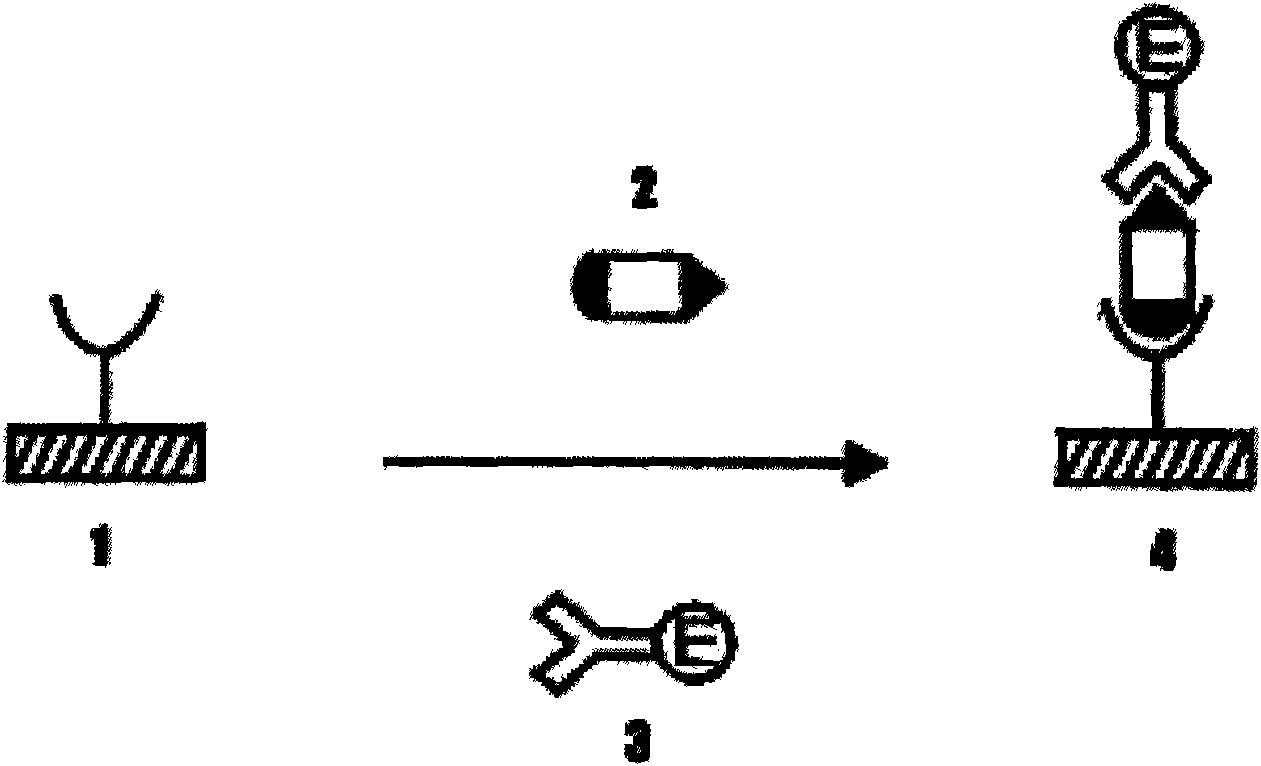Method for detecting circulating antigen for angiostrongylus cantonensis and enzyme-linked immunosorbent assay kit thereof
An enzyme-linked immunosorbent reagent, angiostrongylus technology, applied in the direction of measuring devices, instruments, scientific instruments, etc., can solve the problems of long detection time, cross-reaction, poor repeatability, etc., and achieve simple operation, strong specificity, and high sensitivity Effect
- Summary
- Abstract
- Description
- Claims
- Application Information
AI Technical Summary
Problems solved by technology
Method used
Image
Examples
Embodiment 1
[0053] Example 1: A double-antibody sandwich method for detecting circulating antigens of Angiostrongylus cantonensis:
[0054] Referring to the figure, a double-antibody sandwich method for detecting circulating antigens of Angiostrongylus cantonensis comprises the following steps: (1) selecting two anti-Angiostrongylus cantonensis monoclonal antibodies against different determinants on the adult antigens of Angiostrongylus cantonensis, wherein the anti-Angiostrongylus cantonensis monoclonal antibody Angiostrongylus cantonensis monoclonal antibody A is used to coat the solid phase carrier, and anti-Angiostrongylus cantonensis monoclonal antibody B is used to prepare enzyme conjugates; (2) Drop onto the solid phase carrier (1) coated with anti-Angiostrongylus cantonensis monoclonal antibody A, add enzyme-labeled anti-Angiostrongylus cantonensis monoclonal antibody B (3) at the same time or after incubation, and incubate Finally, the positive specimen forms a sandwich complex o...
Embodiment 2
[0084] Example 2: Preparation and detection method of an enzyme-linked immunosorbent assay kit for detecting circulating antigens of Angiostrongylus cantonensis.
[0085] (1) An enzyme-linked immunosorbent assay kit for detecting circulating antigens of Angiostrongylus cantonensis, comprising:
[0086] ① ELISA plate coated with the original coating: Dilute the monoclonal antibody against the protein secretion of Angiostrongylus cantonensis adult to 2 μg with coating buffer (pH 9.6, 0.05 mol / L carbonate buffer) / ml, add 100μl to each well of a 96-well detachable polystyrene ELISA plate, incubate at 37°C for 2h, pour off the coating solution, wash 2-3 times with 19-fold diluted concentrated washing solution, each time for 30s, and pat dry , then add 200 μl of blocking solution (sample diluent), incubate at 37°C for 1 hour, pour off the liquid in the well, dry and store in a vacuum seal.
[0087] ②Enzyme marker: as described in Example 1, it is HRP marker;
[0088] ③Concentrate...
Embodiment 3
[0098] Embodiment three: detection of kit specificity, sensitivity, precision, stability:
[0099] ①Specific detection: 68 serum samples of SD rats infected with Angiostrongylus cantonensis, 50 serum samples of normal SD rats, 18 serum samples of patients with Angiostrongylus cantonensis, 80 samples of normal human serum, and 2 samples of adult Angiostrongylus cantonensis were selected. Antigen dilution, 2 parts of Angiostrongylus cantonensis protein secretion dilution, 2 parts of Schistosoma japonicum antigen dilution, 2 parts of human roundworm antigen dilution, 2 parts of liver fluke antigen dilution, 24 parts of paragonimiasis patient serum, 18 parts Serum from schistosomiasis patients, 38 serums from liver fluke patients, 27 serums from ascariasis patients, 12 serums from cysticercosis patients, 7 serums from echinococcosis patients, 5 serums from patients with filariasis, prepared in Example 2 The enzyme-linked immunosorbent assay kit for detecting the circulating antige...
PUM
| Property | Measurement | Unit |
|---|---|---|
| Ph | aaaaa | aaaaa |
Abstract
Description
Claims
Application Information
 Login to View More
Login to View More - R&D
- Intellectual Property
- Life Sciences
- Materials
- Tech Scout
- Unparalleled Data Quality
- Higher Quality Content
- 60% Fewer Hallucinations
Browse by: Latest US Patents, China's latest patents, Technical Efficacy Thesaurus, Application Domain, Technology Topic, Popular Technical Reports.
© 2025 PatSnap. All rights reserved.Legal|Privacy policy|Modern Slavery Act Transparency Statement|Sitemap|About US| Contact US: help@patsnap.com

